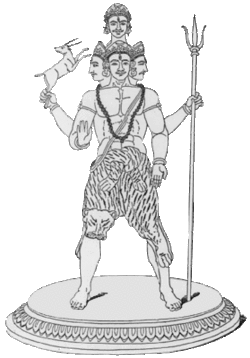
Back অথর্বশীরস উপনিষদ Bengali/Bangla अथर्वशिर उपनिषद Hindi अथर्वशिरोपनिषद Marathi अथर्वशिर उपनिषद Nepali अथर्व-शिर (उपनिषद्) NEW Upaniszada Atharwasiras Polish अथर्वशिरोपनिषत् Sanskrit அதர்வசிரசு உபநிடதம் Tamil Атхарвашира Tatar
| Atharvashiras Upanishad | |
|---|---|
 Rudra | |
| Devanagari | अथर्वसिरस् |
| IAST | Atharvaśiras |
| Title means | Main point of the Atharvaveda[1] |
| Date | 1st millennium BCE |
| Type | Shaiva |
| Linked Veda | Atharvaveda |
| Chapters | 7[2] |
| Philosophy | Pashupata, Vedanta[1] |
| Part of a series on |
| Shaivism |
|---|
 |
|
|
The Atharvashiras Upanishad (Sanskrit: अथर्वसिरस् उपनिषत्) is a Sanskrit text that is one of the minor Upanishads of Hinduism. It is among the 31 Upanishads associated with the Atharvaveda.[3] It is classified as a Shaiva Upanishad focussed on god Rudra.[4][5]
The Upanishad is notable for asserting that all gods are Rudra, everyone and everything is Rudra, and Rudra is the principle found in all things, their highest goal, the innermost essence of all reality that is visible or invisible.[1] Rudra is Atman and Brahman, and in the heart.[1][6] Rudra's symbol is Om, states the text, he can be realized by abandoning anger and lust, and through silence alone.[1] The text is known for its monism (Advaita), and was quoted extensively by the German philosopher Hegel.[7][8]
It is also known as Atharvasirasopanishad, Atharvashira, Atharvasira in some texts referencing it, and as Śira Upanishad in Muktikā canon of 108 Upanishads.[9]
Being a Shaiva Upanishad, it is also known as Shiva-Atharva-Sheersham or Shivātharva-Sheersham.[10]
- ^ a b c d e Deussen, Bedekar & Palsule (tr.) 1997, p. 769.
- ^ Deussen, Bedekar & Palsule (tr.) 1997, pp. 769–778.
- ^ Prasoon 2008, p. 82-83.
- ^ Farquhar 1920, p. 364.
- ^ Tinoco 1997, p. 87.
- ^ Ramachander, P. R. "Atharvasiras Upanishad". Vedanta Spiritual Library. Archived from the original on 2015-09-23. Retrieved 2015-01-24.
- ^ Cite error: The named reference
viyagappa25was invoked but never defined (see the help page). - ^ H Glasenapp (1974), Die Philosophie der Inder, Kröner, ISBN 978-3520195036, pages 259-260
- ^ Deussen, Bedekar & Palsule (tr.) 1997, pp. 558–563.
- ^ Sharma 2020, pp. 5–8, see Bibliography.
© MMXXIII Rich X Search. We shall prevail. All rights reserved. Rich X Search